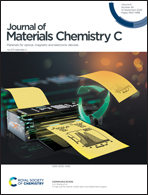Self-assembly of noble metal-free graphene–copper plasmonic metasurfaces†
Abstract
The strong light confinement and near field enhancement by metallic scatters enabled the development of a large family of plasmonic-based technologies, including broadly used gold metasurfaces. Despite progress, the engineering of non-precious metal plasmonic devices remains challenging, due to the limited chemical stability of most nanostructured metals. Here, we report the preparation of earth-abundant plasmonic metasurfaces by the engineering of copper-graphene nano-resonators, and their use as localized surface plasmon resonance (LSPR) sensors. We achieve the large-scale self-assembly of Cu nanocrystals, featuring a protective graphene film, by one-step reduction of CuO nanoparticle networks in a hydrocarbon-containing atmosphere. Microscopic and spectroscopic investigations reveal that coalescence and reduction of the CuO nanoparticles during graphene growth result in the formation of graphene-encapsulated metallic Cu nano-islands (NIs). These Cu–graphene metasurfaces can detect down to 1% concentrations of toluene gas at room temperature, displaying a reproducible and rapid LSPR shift of 0.2 nm. Finite-difference time-domain (FDTD) simulation and structural characterization reveal that the graphene layer significantly improves the Cu crystals’ long-term stability, leading to a prolonged LSPR performance over periods of three months. These insights provide promising directions for the development of earth-abundant plasmonic materials with applications ranging from biosensing to photo-catalysis and other optoelectronic devices.



 Please wait while we load your content...
Please wait while we load your content...